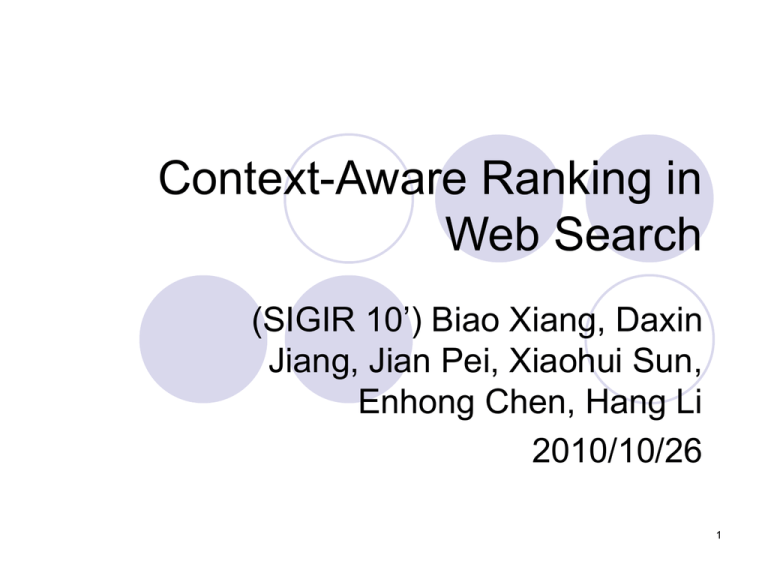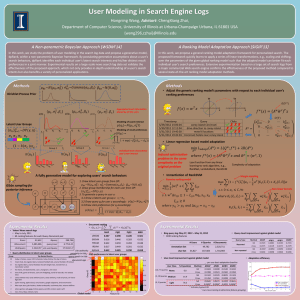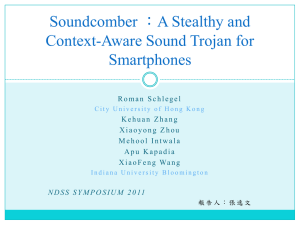Context-Aware Ranking Principles
advertisement

Context-Aware Ranking in Web Search (SIGIR 10’) Biao Xiang, Daxin Jiang, Jian Pei, Xiaohui Sun, Enhong Chen, Hang Li 2010/10/26 1 Outline Introduction Ranking Principles Context-aware Ranking Principles Effectiveness of Principles Context-Aware Ranking Experimental Results Conclusions 2 Introduction almost all the existing ranking models consider only the current query and the documents do not take into account any context information the previous queries in the same session the answers clicked on skipped by the user to the previous queries 3 two critical problems about context-aware ranking for Web search How can we take advantage of different types of contexts in ranking? How can we integrate context information into a ranking model? discuss the types of contexts and propose ranking principles evaluate the effectiveness of the principles incorporate context information into a learningto-rank model 4 Ranking Principles *Context-Aware Ranking Principles Reformulation C S C S Principle 1 (Reformulation). For consecutive queries in a session such that qt reformulates , if a search result d for is clicked on or skipped, as a result for is unlikely to be clicked on and thus should be demoted. 5 Specialization Principle 2 (Specialization). For consecutive queries in a session such that qt specializes , the user likely prefers the search results specifically focusing on . 6 Generalization Principle 3 (Generalization). For consecutive queries in a session such that generalizes , the user would likely not prefer the search results specifically focusing on qt−1. 7 General Association Principle 4 (General association). For consecutive queries in a session such that and are generally associated, the user likely prefers the search results related to both and qt. Such results should be promoted for qt. 8 How to import the principles Principle2 :the set of terms appearing in query but not in query . promote the results matching in the set of answers to . Principle3 :the set of terms appearing in query but not in query . promote the results matching in the set of answers to . 9 Principle4 choose any topic taxonomy such as the Open Directory Project (ODP) ( ): the sets of topics of ( ) : the set of common topics between and promote a search result u if the set of topics of u shares at least one topic with . 10 Ranking Principles *Effectiveness of Principles 37,320 user sessions successive query pairs within the same sessions manually labeled the relations 10, 000 randomly selected successive query pairs. 11 a search result satisfies the principle if should be promoted(2,4) or not(1,3) :the set of search results that satisfy the principle :consists of the search results that were clicked on by the users estimated Δ = P(c = 1|h = 1)− P(c = 1|h =0) 12 Evaluation in Different Types of Contexts the two successive queries match the relation of the principle Evaluation in All Contexts 13 Context-Aware Ranking RankSVM : an SVM model for classification on the preference between a pair of document. the original ranking list from the search engine the list from the RankSVM RankSVM-R0 RankSVM-R1 RankSVM-F re- ranking 14 Experimental Results 1500 cases, 1000 for training,500 for validation , 15 Conclusions human labeled data and user click data complementary to each other the four context-aware methods are better than the search engine the effectiveness of contextaware ranking. all three RankSVM methods perform better than the baseline in context-aware ranking. consider different types of contexts in Web search. the RankSVM-F and RankSVM-R1 methods show larger improvements than RankSVM-R0 the usefulness of considering the original ranking of the search engine. 16










